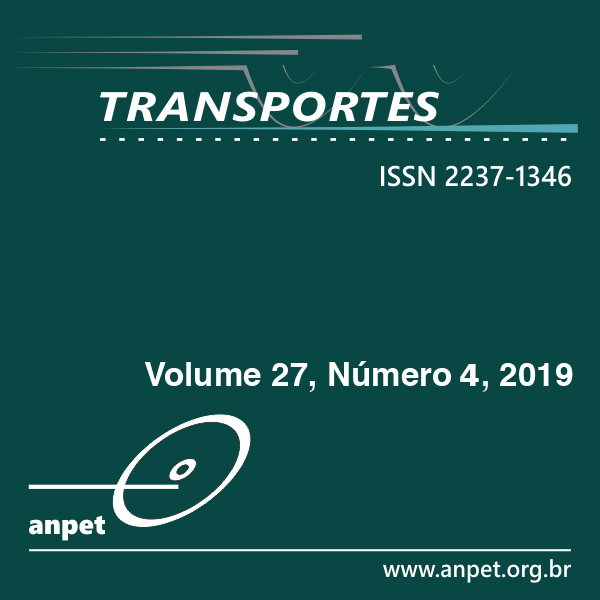Utilização do ensaio de flexão sobre amostra semicircular para avaliação da propagação do trincamento em misturas com diferentes ligantes
DOI:
https://doi.org/10.14295/transportes.v27i4.1832Keywords:
Cracking, EEFAS, EDFAS.Abstract
This paper aims to investigate cracking propagation and asphalt mixtures failure. Cracking is considered one of the major distresses mechanisms affecting the serviceability and quality of flexible pavement structures. This study evaluated cracking resistance, as well as the principle of cracking propagation in hot mix asphalt with three different types of asphalt binders. The experiment was carried out by means of both static semi-circular bending test (EEFAS) and dynamic (EDFAS). Therefore, this research investigated three asphalt concrete mixes, designed by the Superpave method: one with conventional neat binder (CAP), one polymer modified (AMP) and a third asphalt-rubber binder mix (AB), namely mixes A, B and C. The results indicated higher stiffness of the AMP mixture, which also presented greater fatigue life. Conversely, the specimens with CAP and AB demonstrated more ductility, with less microcracks propagation speed.Downloads
References
Al-Qadi, I.; Ozer, H.; Lambros, J.; El Khatib, A.; Singhvi, P.; Khan, T.; Rivera, J. e Doll, B. (2015) Testing Protocols to Ensure Per-formance of High Asphalt Binder Replacement Mixes Using RAP and RAS. Illinois Center for Transportation. Research Re-port, No. FHWA-ICT-15-017.
AASHTO (2013) M 323: Standard specification for Superpave Volumetric Mix Design. Washington, DC.
AASHTO (2013) TP 105: Standard Method of Test for Determining the Fracture Energy of Asphalt Mixtures Using the Semi-Circular Bend Geometry (SCB). Washington, DC.
AASHTO (2016) TP 124: Determining the Fracture Potencial of Asphalt Mixtures Using Semicircular Bend Geometry at In-termediate Temperature. Washington, DC.
AASHTO (2011) T 283: Standard method of test for resistance of compacted asphalt mixtures to moisture-induced damage. Test Standard Specifications for Transportation Materials and Methods of Sampling and Testing. Washington, DC.
Aragão, F.T.S.; Hartmann, D.A.; Kim, Y.R.; Motta, L.M.G. e Javaherian, M.H. (2014) A numerical-experimental approach to characterize fracture properties of asphalt mixtures at low in-service temperatures. Transportation Research Record: Journal of the Transportation Research Board, Washington, D.C. 2447, 42-50. https://doi.org/10.3141/2447-05
ABNT (2011) NBR 16018: Misturas asfálticas – Determinação da rigidez por compressão diametral sob carga repetida. Rio de Janeiro.
ABNT (2012) NBR 15087: Misturas Asfálticas – Determinação da Resistência à Tração por Compressão Diametral. Rio de Janeiro.
Balbo, J.T. (2000) Fatos, Mitos e Falácias sobre os Modelos Experimentais de Fadiga. In: Reunião Anual de Pavimentação, v. 1, p. 391-404, Brasília.
Balbo, J.T. (2007) Pavimentação asfáltica: materiais, projeto e restauração. Oficina de Textos, São Paulo.
Departamento Nacional de Infraestrutura de Transportes (2006) DNIT 031: Pavimentos Flexíveis – Concreto Asfáltico – Especificação de Serviço. Rio de Janeiro.
Departamento Nacional de Infraestrutura de Transportes (2009) DNIT 112: Pavimentos Flexíveis – Concreto asfáltico com asfalto-borracha, via úmida, do tipo “Terminal Blending” – Especificação de Serviço. Rio de Janeiro.
Elseifi, M. A.; Mohammad, L.; Yang, H. e Cooper, S. (2012) Modeling and evaluation of the cracking resistance of asphalt mix-tures using semi-circular bending test at intermediate temperatures. Road and materials and pavement design, 13, 124-139. DOI: 10.1080/14680629.2012.657035
European Committee for Standardization (2010) EN 12697-44: Bituminous Mixtures – Test Methods for Hot Mix Asphalt Part 44: Crack Propagation by Semi-Circular Bending Test. Brussels, Belgium.
Gao, L. e Ling, C. (2016) Evaluation of fatigue behavior in cold recycled mixture using digital image correlation method. Construction and Building Materials 102, 393-402. https://doi.org/10.1016/j.conbuildmat.2015.11.014
Godoi, L.G.; Brito, L.A.T. e Ceratti, J.A.P. (2017) Ensaio semicircular de flexão para análise da resistência ao trincamento de misturas asfálticas: validação e interpretação do procedimento. Congresso Íbero-Latinoamericano del Asfalto, Medellín, Colômbia.
Huang, B.; Shu, X. e Zuo, G. (2013) Using notched semi circular bending fatigue test to characterize fracture resistance of asphalt mixtures. In: Engineering and fracture mechanics 109, 78-88.DOI: 10.1016/j.engfracmech.2013.07.003
Kim, Y.R.; Little, D.N. e Song, I. (2003) Effect of mineral fillers on fatigue resistance and fundamental material characteristics – mechanistic evaluation. Transportation Research Record, Washington, DC, 1832, 1-8. https://doi.org/10.3141/1832-01
Li, X. J. e Marasteanu, M.O. (2010) Using the Semi Circular Bending Test to Evaluate Low Temperature Fracture Resistance for Asphalt Concrete. Experimental Mechanics, 50(7), 867-876. https://doi.org/10.1007/s11340-009-9303-0
Molenaar, A.A.A.; Scarpas, A.; Liu, X. e Erkens, S.M.J.G. (2002) Semi-circular bending test; Simple but useful. Journal of Associa-tion of Asphalt Paving Technologies, 71, 794-815.
Montestruque, G.; Vasconcelos, K.L. e Bernucci, L.L.B. (2010) Ensaio de flexão em amostra semi-circular com fenda e análise de imagens para caracterização da resistência à fratura de misturas tipo AAUQ. XXIV Anpet Congresso de Pesquisas e Ensino em Transportes, Salvador, Bahia.
Nsengiyumva, G. e Kim, Y.R. (2019) Effect of testing configuration in semi-circular bending fracture of asphalt mixtures: experiments and statistical analyses. TRB Annual Meeting, Washington, DC, 2673(5), 320-328.https://doi.org/10.1177/0361198119839343
Vargas, G.A.B; Oliveira, A.D e Aragão, F.T.S. (2018) Influência do modo de aplicação de carga nas propriedades de fratura de uma mistura asfáltica de agregados finos. Transportes, 26(3), 39 – 50. DOI: 10.14295/transportes.v26i3.1609
Downloads
Published
How to Cite
Issue
Section
License
Authors who submit papers for publication by TRANSPORTES agree to the following terms:
- The authors retain the copyright and grant Transportes the right of first publication of the manuscript, without any financial charge, and waive any other remuneration for its publication by ANPET.
- Upon publication by Transportes, the manuscript is automatically licensed under the Creative Commons License CC BY 4.0 license. This license permits the work to be shared with proper attribution to the authors and its original publication in this journal, and to be adapted for non-commercial purposes, provided appropriate credit is given and any derivative works are distributed under the same terms.
- Authors are authorized to enter into additional separate contracts for the non-exclusive distribution of the version of the manuscript published in this journal (e.g., publishing in an institutional repository or as a book chapter), with recognition of the initial publication in this journal, provided that such a contract does not imply an endorsement of the content of the manuscript or the new medium by ANPET.
- Authors are permitted and encouraged to publish and distribute their work online (e.g., in institutional repositories or on their personal websites) after the editorial process is complete. As Transportes provides open access to all published issues, authors are encouraged to use links to the DOI of their article in these cases.
- Authors guarantee that they have obtained the necessary authorization from their employers for the transfer of rights under this agreement, if these employers hold any copyright over the manuscript. Additionally, authors assume all responsibility for any copyright infringements by these employers, releasing ANPET and Transportes from any responsibility in this regard.
- Authors assume full responsibility for the content of the manuscript, including the necessary and appropriate authorizations for the disclosure of collected data and obtained results, releasing ANPET and Transportes from any responsibility in this regard.









